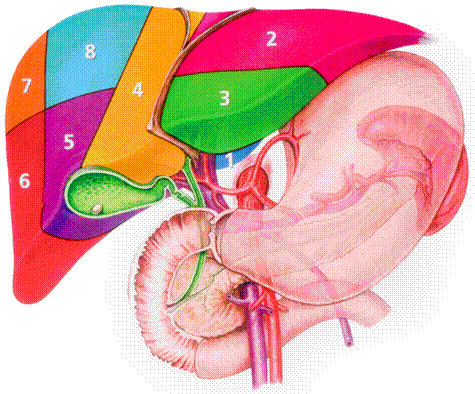Liver Cancer
What is the Liver?
The Liver is the largest organ in the body and lies under the right side of the abdomen under the rib cage. The liver has many functions including, filtering and production of blood cells, production of bile used to digest fats, clearance of waste products from the body, production of glucose, protein and cholesterol in the body.
What is Liver cancer?
Liver cancer worldwide is a primary cancer commonly known as Hepatocellular carcinoma (HCC). Patients that develop liver cirrhosis are at a higher risk of developing HCC. Common causes of cirrhosis include viral hepatitis (B or C), excessive alcohol consumption and other conditions such as Haemochromatosis (iron metabolism abnormality) and Wilson's disease (copper metabolism abnormality). More common in the western world is spread to the liver from other cancers (secondary cancer). The most common source of cancer spread to the liver (metastases) are from colorectal (bowel) cancer, with other metastases also possible from, the kidneys, breasts, lungs, adrenal glands, pancreas and stomach.
Bowel cancer spread to the liver (colorectal live metstases) is the most common reason why patients undergo liver surgery/ resection in the U.K.
How does secondary liver cancer (colorectal liver metastases) present?
Colorectal liver metastases do not usually present with any symptoms and are routinely monitored by regular scans after the primary bowel cancer has been removed. Bowel cancer patients undergo routine ultrasound or Computer Tomography (CAT) scans which will detect and tumour deposits in the liver.
In some patients if the cancer spread is extensive they may develop symptoms of increasing nausea, poor appetite and weight loss.
Click here for Guidelines on the treatment of colorectal liver metastases.
How is secondary Liver Cancer diagnosed?
The diagnosis of secondary liver cancer, particularly from bowel (colorectal liver metastases), is made following a careful consultation with your specialist surgeon who will examine you and order certain specialised blood tests (CEA) in addition to a CAT scan. If a CAT scan identifies colorectal liver metastases a Magnetic Resonance Scan (MR) is performed prior to consideration of surgery. MR scans are radiation free and provide more sensitive imaging of smaller deposits in the liver as well as with a 'road map' for the surgeon before surgery is considered. In some cases a PET (positron emission tomography) scan is performed which is very sensitive at detecting cancer spread in other organs and lymph nodes around the body.
What are the common types of secondary Liver Cancer?
Metastases to the liver are treatable by surgery for the following cancers:
1) Bowel/ Colorectal (commonest)
2) Kidney/ Renal
3) Adrenal glands
4) Carcinoid
5) Gastrointestinal stromal tumours (GIST)
How can secondary liver cancer be treated?
The majority of diagnosed liver colorectal metastases are still not amenable to surgical treatment, with only up to 25-35% of patients undergoing surgery.
Surgery if successful can give a 35-50% 5 year survival for patients. Further surveillance is required with regular CAT scans with further surgery possible in selected patients if necessary. If surgery is initially not possible, chemotherapy can be given to try and 'shrink' the tumours in the liver down which may then allow surgery (down-staging chemotherapy).
What Surgery is involved?
Surgery on the liver is very safe with most patients remaining in hospital for at least 7-10 days. Surgery can be undertaken by both open and keyhole techniques (see diagram below). The keyhole 'laparoscopic' technique is only possible for selected patients and depends on where the tumours are on the liver (see diagram below).
The type of surgery you may require will be discussed with you by your surgeon.
In modern liver surgery the wounds are generally small with large operations/ resections performed by a single incision/cut just below the right rib cage. Immediately following surgery for the first 24 to 48 hours patients are managed on the progressive care unit with transfer to their private room for the remainder of their stay. Up to 65% of the liver can be removed safely with the remaining liver regenerating in a matter of a few weeks to compensate. Complete recovery after discharge takes at least a further four to six weeks.
What are the effects of Surgery?
Following a liver resection, patients do take time to recover, with a return to normal eating taking in some cases at least one to two months. Patients can lose weight after surgery but usually start to regain weight as well as full activities within a month or two. Wounds can cause some problems with infection and pain following surgery.
Do all patients have Surgery? - Non-Surgical Treatment
Unfortunately not all patients are able to undergo surgery for colorectal liver metastases. Other treatments include chemotherapy as well as Radiofrequency ablation and microwave ablation. These treatments are very specialised and your surgeon will discuss all the options with you at the time of your consultation.
Liver Diagram
The Liver is divided into eight segments based on its blood supply. Surgery is guided by where any possible tumours are in the liver and can be undertaken in some patients by keyhole surgery.
 .
.